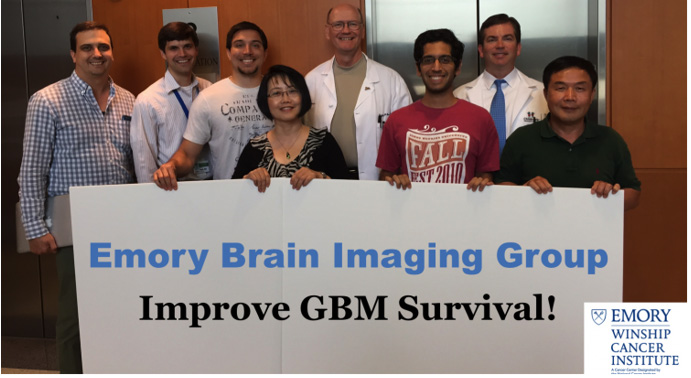Search QIN

Emory University
Quantitative Magnetic Resonance Spectroscopic Imaging to predict early response to therapy in new GBM management
Hyunsuk Shim, Ph.D.
hshim@emory.edu
Grant Number: U01 CA172027
Glioblastoma multiforme (GBM) is the most common primary brain tumor and is uniformly fatal. During carcinogenesis, tumor suppressor genes are silenced by aberrant histone deacetylase (HDAC) activity. Reversing this modification has become a goal for tumor therapy. Belinostat is a potent inhibitor of HDAC that crosses blood-brain-barrier (BBB). This agent may not only help control tumors but also alter cerebral biochemistry to improve depressive symptoms afflicting many GBM patients. However, the lack of reliable biomarkers to predict early response severely hampers the treatment of GBM patients with HDAC inhibitors. Magnetic resonance imaging (MRI) is the standard tool for monitoring therapeutic response in GBMs. Although useful, conventional MRI has shortcomings including difficulty at distinguishing true tumor progression from “pseudo-progression” that is often seen soon after completion of chemoradiation. MRI may also not be ideal for evaluating new therapies, many of which help only a subset of patients. For GBMs, therapeutic response is mainly evaluated by assessing for tumor changes on conventional MRIs, since repeat surgical biopsy is too invasive and may be prone to sampling error. However, this is not ideal for evaluating response to belinostat since our preliminary data indicate that drug response is associated with re-differentiation rather than killing/shrinking tumors, which may normalize cancer cell metabolism. While conventional MRI detects tumor size and location, it cannot detect this type of normalization. We propose to fill this void by using spectroscopic MRI (sMRI), which uses special techniques in an MRI scanner to measure the metabolism of cancer cells as well as normal brain. While MRS is not new, it has not gained widespread clinical use due to poor resolution, long scan times, and difficulty integrating with other types of brain scans. We propose to implement state-of-art MRSI technology that can rapidly generate metabolite maps of the entire brain coupled with introduction of an imaging registration/analysis program that combines sMRI data with other imaging studies in a clinically useful fashion. Our long-term goal is to develop sMRI into a practical clinical tool that can be readily implemented at most institutions. The establishment of reliable sMRI metabolic biomarkers to assess early response would be of great value in developing new treatments, especially those such as HDAC inhibitor which do not work by simply killing cells. By allowing clinicians to detect normalization of cancer metabolism in as little as a few weeks of therapy, patients destined to benefit from treatment may be reassured, while those not showing a metabolic response can be switched from an ineffective treatment without further wasting of time. This would clearly be a highly innovative use of MRS. Importantly, in addition to monitoring tumor response to HDAC inhibitor therapy, our MRS-based tool will allow assessment of the biochemical content of normal brain, and may thus indirectly monitor the subject’s quality-of-life.
https://brainimaging.emory.edu/
References
Cordova, J.S., Kandula, S., Gurbani, S. S., Zhong, J., Tejani, M., Kayode, O., Patel, K., Prabhu, R., Schreibmann, E., Crocker, I., Holder, C.A., Shim, H., Shu, H.G. The impact of integrating volumetric whole-brain spectroscopic MRI into radiation treatment planning for glioblastoma. Tomography, 2(4): 366-373. PMC5241103
Cordova, J.S., Gurbani, S. S., Olson, J.J., Liang, Z., Cooper, L.A.D., Shu, H.G., Schreibmann, E., Neill, S., Hadjipanayis, C.G., Holder, C.A., Shim, H. (2016) A systemic pipeline for the objective comparison of whole-brain spectroscopic MRI with histology in biopsy specimens from grade III glioma. Tomography, 2(2): 106-116. PMC4968944.
Cordova, J.S., Shu, H.G., Liang, Z., Gurbani, S. S., Cooper, L.A.D., Holder, C.A. Olson, J.J., Kairdolf, B., Schreibmann, E., Neill, S., Hadjipanayis, C.G., Shim, H. (2016) Whole-brain, spectroscopic MRI biomarkers identify infiltrating margins in glioblastoma patients. Neuro-Oncology, Neuro-Oncology, 18(8): 1180-9. PMC4933486
Cordova, J.S., Gurbani, S. S., Holder, C.A. Olson, J.J., Schreibmann, E., Shi, R., Guo, Y., Shu, H.G., Shim, H., Hadjipanayis, C.G. (2016) Semi-automated volumetric and morphological assessment of glioblastoma resection with fluorescence-guided surgery. Molecular Imaging and Biology, 18(3): 454-62. PMC4862927.
Shim, H., Wei, L, Holder, C., Guo, Y., Hu, X., Miller, A., Olson, J.J. (2014) Managing glioblastoma patients using high resolution volumetric MR spectroscopic imaging. American Journal of Roentgenology. 203(2): W158-65. PMC4283208.
Cordova, J.S., Schreibmann, E., Hadjipanayis, C.G., Guo, Y., Shu, H.G., Shim, H., Holder, C.A. (2014) Quantitative tumor segmentation for evaluation of extent of glioblastoma resection to facilitate multisite clinical trials. Translational Oncology, 7: 40-7. PMC3998691.






